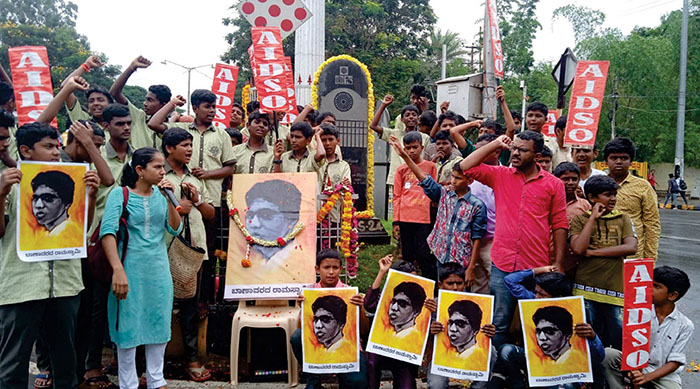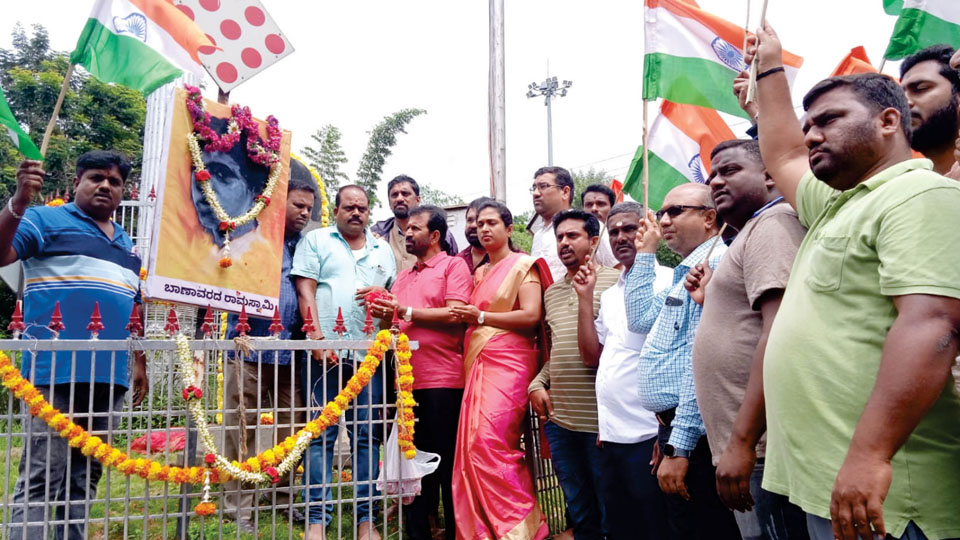Mysore/Mysuru: The 75th death anniversary of young freedom fighters Banawara Ramaswamy (in whose name Ramaswamy Circle in the city stands), Kadakola Toranayaka and Ranga, who died in Police firing during the ‘Mysore Chalo’ movement in 1947 were remembered at a programme organised by Yuva Bharat at Ramaswamy Circle here yesterday.
Floral tributes were offered to the portraits of the martyrs and Ramaswamy Memorial.
Speaking on the occasion, MLA L. Nagendra said that three youngsters including Ramaswamy died in the Police firing that took place on Sept. 13, 1947 during the Mysore Chalo.
Pointing out that the nameboard of Ramaswamy would be installed on all the five roads leading to the Circle, which is ever busy, Nagendra recalled how students had organised the Mysore Chalo movement at the Circle, which was then known as Five Lights Circle.
Stating that in 1947, the then Deputy Commissioner of Mysuru Nagarajarao had ordered firing when Ramaswamy and his fellow students surged to hoist the National Flag at the Circle, the MLA said that the heroics of the students then are an inspiration to the young generation of today in respect of Patriotism and Nationalism.

Mayor Shivakumar, in his address, said that a committee will be constituted for holding programmes to remember the icons of the city who had made enormous contributions and sacrifices.
Corporator Pramila Bharath, MUDA member Naveen Kumar, Yuva Bharat’s Ajay Shastri, BJP leader Jogi Manju, leaders Rakesh Bhat, Paduvarahalli M. Ramakrishna, KRS Vijay Kumar, Girish, Naveen, Ravi Shastri, Ranganath, Vikas Shastri, Sucheendra, Sharath, Nagesh, Chakrapani and others were present at the event.
The AIDSO too observed the 75th death anniversary of Ramaswamy at another programme organised at Ramaswamy Circle in the heart of the city.
Addressing the gathering, District AIDSO (All India Democratic Students Organi-sation) President B.J. Subash said that Ramaswamy was a brave teenager when he felled to a bullet while trying to hoist the National Flag.
Maintaining that Ramaswamy jumped into the freedom movement when he was just 17 years old, he said that Ramaswamy played a very vital role in Mysore Chalo Movement, which ultimately led to the installation of a democratic and responsible Government in the then Princely State of Mysore and thereby acceding to the Indian Union.
AIDSO office-bearers Chandrakala, Asiya Begum and others were present.








How can it be his 75th birth anniversary if he jumped into freedom movement at 17? It has 75 years since independence. So either, this is 92+ birth anniversary or he joined the freedom movement before he was born 🙂
@Thimmaiah
Hello ‘Manku Thimma’
Read this bit in the above article: “The 75th death anniversary of young freedom fighters Banawara Ramaswamy (in whose name Ramaswamy Circle in the city stands), Kadakola Toranayaka and Ranga, who died in Police firing during the ‘Mysore Chalo’ movement in 1947″
It says ‘death anniversary”. You need to exercise your brain, if you have some thing called ‘brain’
But, what you should be questioning is this: “Speaking on the occasion, MLA L. Nagendra said that three youngsters including Ramaswamy died in the Police firing that took place on Sept. 13, 1947 during the Mysore Chalo”
We all know, India became independent on August 15, 1947. Why should this teen ager Ramaswamy should agitate, after India gained independence. The date about must be wrong. It should be before 1947, I heard in my younger days in Mysore, that this agitation took place in 1946.
Even that agitation I am puzzled about. The Labour Party in Britain under Clement Atlee promised independence to India, when he got elected to become the prime minister of Britain. After the WWII victory, in the British general election in 1945, Clement Atlee won the election. Hence, from my parents I heard that Congress leaders in India, including Mahatma Gandhi and Nehru, believed that India will get independence soon.
The independence agitation under Gandhiji, hence was wound down believing Clement Atlee’s promise. My cousin who was also a student then, my father said , was also winding down his agitation in Tamil Nadu.
My college principal in late 1950s who was a freedom fighter , narrated the story of Ramaswamy and his death. We discussed in the class as part of the chapter in the new subject ‘social science’ in the new PUC course introduced then .
Actually, by 1946, firm plans were under way for Atlee to formally announce independence for India in early 1947, which he did in February 1947.
Then, why did this teen ager agitated so much in 1946, causing the uproar which resulted in his killing? In the above PUC class, we got no satisfactory answer too.
Adding insult to injury: ” Vandemataram2″ , the rallying cry in independence movement, was not adopted as the National Anthem. Instead, Rabindra Nath Tagore’ ” Janagana mana” piece was adopted although , Tagore was accused that he wrote it in praise of the king : George V , which he denied.. see: https://timesofindia.indiatimes.com/blogs/cash-flow/the-controversial-history-of-indias-national-anthem/
But who was the ‘Bharatah Bagyavidata’in that song? it was meant to be :’George v’emperor the supreme cort judge in that link said. Tagore satifsfactory reply was not forthcoming. It should be noted that Tagore had close connection with England, and was a friend of W B Yeats, the Irish poet who was living in England then, and who recommended Tagore’ for the Nobel Prize for literature, which he won.
Not only poor Ramaswamy died, in 1946, under the above circumstance, the song during years of independence struggle: ” Vandemataram'” did not become the national anthem.
Very sad indeed.
Note to The editor Vikram: Please correct the date 13 September 1947 mentioned. India had already become independent the previous month: 15 August 1947. Hence, no purpose in the said agitation!
I studied in the only engineering college in Mysore in 1950s, and had very often cycle around this circle. In my recollection of hearing stories from those who were friends of Ramaswamy, that this tragedy occurred in 1946, and he was shot by a Mysorean deputy commissioner, who could have let Ramaswamy to protest and this crowd was not violent. So many agitations took place in my native Kerala more violent by youths in respect of demanding independence, and no one was shot dead.
The main reason I heard at that time was that JC Wadiyar was still the Maharaja, and his government controlled the law and order of the state, and unlike Nalwadi Wadiyar who controlled the state through efficient officials,who Would have prevented this to happen, JC Wadiyar had always been a docile and ineffectual Maharaja; one could see he achieved nothing in his life as compared to his illustrious uncle Nalwadi Wadiyar.
I agree that Atlee had already been the PM of Britain and assured independence to India. The discussions were conducted from the Indian side by Gandhiji and Nehru mainly with Muhammad Ali Jinnah spoiling the discussions, refusing to accept independence of India as it was at that time, unless his Muslims get a separate country out of it. He stalled and spoiled the progress. Otherwise, India would have become independent a year earlier in 1946.
I have read Mr Ganapathy’s yearly pieces on this, and should say he is wrong in asserting that Lord Mountbatten partitioned India. It was Muhammad Ali Jinnah, who wanted to partition to get a Mulim country, and did not accept Gandhiji offer of making him the PM oft he then India, as long as he wanted. Muhammad Ali Jinnah rejected this offer. The viceroy was left with no option.
Muslims then and now are always the menace to India.a
People in the South including the prominent Congress leaders of the South were kept in the dark about the progress of independence talks, as it was carried by only 2 Indian leaders: Gandhiji and Nehru with the Atlee Labour government. VK Krishna Menon then a Labour party councillor in Camden-a borough in London, had close friends in the Atlee government, and he was involved too in the talks in London.
In the opinion of many in the South India-Gandhiji and Nehru should have travelled in South India in 1946 assuring people that India will get independence soon. They did not do it. It was a huge mistake, as Atlee government announced soon-in the beginning of 1947, that India would get its independence.
One thing was clear. Indian independence agitations were toned down after Atlee became the British PM, expecting independence, which Atlee assured before the election in Britain in 1945. Hence, it was not necessary for the crowd of this young men led by Ramaswamy to agitate in 1946, when it was known that India would be independent in a matter of time-soon.
The British, particularly never interfered with Wadiyars’ regime, unlike in any other state in India, except Kerala. Nalwadi Wadiyar had full powers, and hence he so effectively ran the state. His successor JC Wadiyar did not. Hence the DC was able to do what he did by shooting Ramaswamy. Despite journalists like Gouri Satya’s claims, about JC Wadiyar, the Maharaja did not have the mettle of Nalwadi Wadiyar.
It is a very tragic story about this bright young man Ramaswamy, who should never have died.
Who were his parents? Nothing about them was known even in 1950s. They must have suffered massive grievance as lonmg as they lived, every minute and every day of their lives after losing their son.
It appeared thatv Mysore DCs never learned. In 1960s, there was a student agitation, mostly peaceful, mainly in the then 100 feet road,.The police were so hostile that we had to quickly move away from the spot. The police never attempted to talk to the student leaders, to pacify them, and thus bring the agitation to a halt. Intead they resorted to lathi chrge, and when this did not bring the crowd to halt, they asked the DC to agree to firing,which the stupid DC did. One student was killed and many were injured. This incidence was hushed up, through an eye wash enquiry which cleared the DC and the police. Lies were told about these students pelting stones, which they did not. The DC went on to become secretary in the Congress government in the state and later at the centre, retired with a huge pension and lived in a mansion away from Mysore in his retirement!
Talking about peaceful agitations for a political cause and police killing .
In the US, particularly in the state of Alabama, where George Wallace rule, civil rights movement , most of them peaceful to demand equal rights as American citizens and put an end to the horrible segregation, were always met with police violence and firing. Many died.
The notorious Kent State killing where many university died protesting against the Vietnam war-justifiable because, young bodies were required as soldiers to fight the Vietcongs in the marshy jungles of Vietnam, the conscription in the US meant that social security numbers of American citizens and greencard holding foreigners too, below a certain age were used as lottery numbers and picked to send them to training for a very brief period, before sending them to Vietnam jungles to certain death. American students took graduate courses, normally they did not after their undergraduate degrees to prevent this.
President Nixon mired in Watergate scandal and also of the Vietnam war, was paranoid and was so sensitive to these political agitations in the university campuses that he preferred them to be dealt with harshly. The State iof Ohio had a bad record in dealing with students’ agitations They were dealt with very harshly indeed. We , students then had to navigate around these protests-hiding the protest emblems pinned to the shirts or jackets- saying for example: ” No to War” , “Impeach RMN ( Richard M Nixon” given to us by our American friends and class mates.